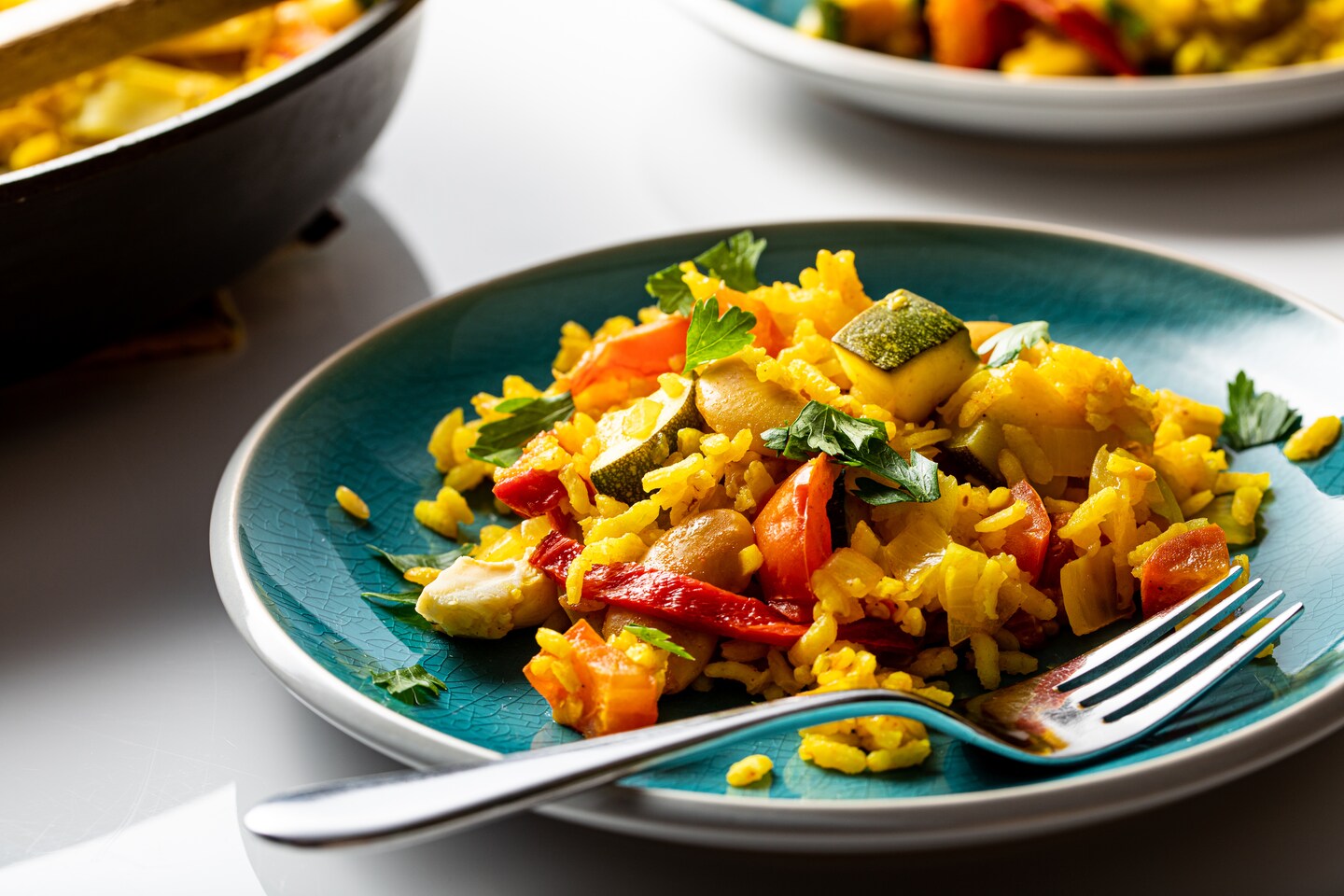This recipe was featured in Week 12 of Voraciously’s Plant Powered newsletter series. For more recipes like this one, and for tips and tricks to help you put more vegetables on your plate, sign up for the newsletter here.
Some of the most gourmet and plant-powered dishes feature … wait for it … rice. Okay, we know rice doesn’t have the allure of steak or scallops for many people. But believe it or not, humble rice transforms into some seriously sexy dishes.
We’re not talking about just any old rice. We’re featuring arborio rice, an oval-shaped short-grain rice with a pearly white exterior. It’s traditional in Italian risottos, and you can also use it to cook Spanish paella. The dishes are polar opposites in cooking method, and both are absolutely divine.
Paella is a traditional Spanish dish: It’s showy, versatile and feels like a celebration every time. It’s served right in the pan with a vibrant array of veggies, meat and seafood. While it’s often made with short-grained bomba rice, arborio rice is easier to find in the United States and holds up well in paella, too.
A good paella maker knows the mantra, “do not stir.” Do not even think about stirring your paella, or you’ll end up with a gummy mess. Rather, set it and forget it: The broth cooks slowly through the rice, leaving a tender, saffron-scented delight behind. When making one-pot rice dishes such as paella, keep the following in mind:
Measure and chop everything ahead of time. The upfront cooking goes quickly, so we like to have everything measured, chopped and ready to go.
Pay attention to heat. If it’s too high you’ll get crunchy rice; too low and you’ll get soggy rice. Pay close attention to the heat levels specified in the recipe and adjust accordingly.
Center the pan. Make sure to keep the pan centered over the heat source for evenly cooked rice.
This paella is fit for a small-scale dinner party or a weeknight family meal. It uses traditional Spanish methods while employing cooking tools you already have in your kitchen — no paella pan required.
The bright jumble of veggies and yellow rice is a true showstopper. (Want to add seafood? Saute shrimp or scallops before you start the paella, then add them to the top with the quartered artichokes and sliced red peppers.)
Serve with a Spanish red or white wine (might we recommend a tempranillo or an albariño?) and a side of manchego cheese and olives.
Recipe notes: Lupini beans are large white beans that you’ll find sold in jars in the grocery aisle with beans, or near specialty products such as olives and jarred roasted red peppers. If you can’t find them, look for canned butter beans, or use any canned white bean.
Saffron is on the pricey end because of its harvesting method: It is the handpicked stamens of crocus flowers. Because you use only a little per recipe, it’s worth investing in a stash. Saffron adds a unique complexity for which there’s no substitute.
Short-grained bomba rice is a more traditional paella rice than arborio; use it if you can find it.
Refrigerate leftovers for up to 2 days; reheat on the stove top.
Want to save this recipe? Click the bookmark icon below the serving size at the top of this page, then go to My Reading List in your washingtonpost.com user profile.
Scale and get a printer-friendly, desktop version of the recipe here.
Heat the oil in a large skillet (or a paella pan, if you have one) until shimmering over medium-high heat. Add the rice and toast, stirring, until the rice starts to turn light brown, about 2 minutes.
Add the onion and garlic, and cook until coated and fragrant, about 1 minute. Stir in the tomato, zucchini, 1/2 cup of chopped artichokes, 1/2 cup of chopped roasted red pepper and the beans. Cook, stirring constantly, until well combined, about 1 minute.
Add the broth, paprika, saffron, turmeric and salt. Give the mixture a stir, then do not stir again.
Bring to a rapid simmer and cook for 3 minutes, then reduce the heat to medium-low. (Still no stirring.) Artfully arrange the reserved artichoke quarters and thinly sliced roasted red pepper strips on the surface. Make sure the pan is centered on its burner for even cooking.
Continue to cook at a steady bubble until the broth is fully absorbed, 13 to 15 minutes. After 1 full minute with no audible bubbling, turn off the heat. (You can cook the paella a little longer to promote a bottom crust, called socarrat; just proceed at your own risk and pull the pan off the heat before the crust blackens.)
Cool for 5 minutes before serving, then garnish with the chopped parsley. Serve from the skillet.
Per serving (1 3/4 cups)
Calories: 333; Total Fat: 8 g; Saturated Fat: 1 g; Cholesterol: 0 mg; Sodium: 595 mg; Carbohydrates: 55 g; Dietary Fiber: 6 g; Sugar: 7 g; Protein: 10 g
This analysis is an estimate based on available ingredients and this preparation. It should not substitute for a dietitian’s or nutritionist’s advice.
From Sonja Overhiser and Alex Overhiser of ACoupleCooks.com.
Tested by Sonja Overhiser, Alex Overhiser and Becky Krystal; email questions to voraciously@washpost.com.
Scale and get a printer-friendly, desktop version of the recipe here.
Browse our Recipe Finder for more than 9,400 Post-tested recipes.
Did you make this recipe? Take a photo and tag us on Instagram with #eatvoraciously.
More from Voraciously:
Quickly broil eggplant and bread for this bruschetta with garlicky skordalia
5 adaptable lunch recipes for kids heading back to school — and parents, too
7 go-to meatless summer meals, including tacos, tomato sandwiches and noodles
Never ask what's for dinner again. Get one quick, adaptable and creative recipe in your inbox every Monday through Thursday to inspire delicious meals.
By signing up you agree to our Terms of Use and Privacy Policy
This vegetable paella recipe is colorful, festive and quick enough for a weeknight – The Washington Post




